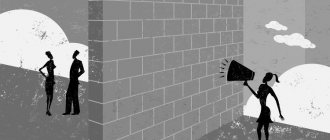Fear of heights is natural for humans and some animals. This fear differs from pathological fear, which can lead to a panic attack - often with hysteria or even loss of consciousness.
When symptoms of acrophobia occur, it is not at all necessary that the person be at a height. Thoughts about heights and corresponding scenes in films can cause deterioration in health, for example: anxiety, rapid heartbeat, tremors of the limbs, increased sweating and dizziness.
Treatment of acrophobia in our clinic is carried out by psychotherapists and hypnologists. Typically, treatment of fear of heights using modern psychotherapeutic techniques, including suggestive ones, and training in relaxation methods takes from 2 months. The intensity of such work requires visiting the doctor 1-2 times a week.
Consultation with a doctor for the treatment of acrophobia:
+7
Thank you for your trust!
- Experienced psychotherapists and hypnologists
- Methods with proven effectiveness
- Medication support
| Service | Price |
| Appointment with a psychotherapist | 4 500 ₽ |
| Family psychotherapy | 10 000 ₽ |
| Hypnotherapy | 6 000 ₽ |
| Psychiatrist consultation | 4 500 ₽ |
Causes of acrophobia
Often, acrophobia occurs as a result of head injury, organic and infectious lesions of the brain. To a lesser extent, the development of a phobia is influenced by family history (the presence of a mental or somatoform disorder in one of the parents). But, as a rule, acrophobia develops under the influence of several reasons.
Acrophobia can also occur due to:
- psychotraumatic situations;
- regular use of surfactants;
- prolonged stress.
Personal negative experiences, as well as characteristics of upbringing (for example, when a child was regularly told that heights are a cause for concern, that he needs to be careful on the playground), can cause the development of acrophobia in people with a weak mental constitution.
Case from practice
In conclusion, we will tell you about a case from the practice of our expert, which inspires optimism and gives hope that getting rid of a phobia that interferes with life is quite possible.
Already an adult married woman, she experienced a painful fear of heights. This greatly limited her travel, which she and her husband loved passionately. However, any kind of activity associated with climbing to a height was closed to them due to the panic horror that the wife experienced, which greatly limited their interests and opportunities. She couldn't climb the mountains, although she really wanted to. The Eiffel Tower and the beauty of Paris that opened from it were completely inaccessible to her.
In the process of working with a psychologist, it turned out that the cause of everything was childhood trauma. As a little girl, on the way from school, our heroine saw a crowd of people who were animatedly discussing something. Coming closer, she saw a man lying on the ground who had fallen to his death from the balcony. What she saw shocked the schoolgirl so much that from then on she became terrified of heights.
Only after the treatment she finally found freedom from her phobia. Some time later, the patient sent the psychologist a photo in which she posed next to her husband on a suspension bridge, confirming that she had completely gotten rid of her fear of heights.
pixabay.com/
Symptoms of acrophobia
Symptoms of acrophobia are somatic (vegetative), mental and behavioral. Depending on the case, they have varying degrees of severity and influence on a person’s life. But it is somatic symptoms that are the reason for seeking help.
Among the vegetative signs of acrophobia the following should be highlighted:
- shortness of breath;
- headache;
- nausea, vomiting;
- tremor of the limbs;
- cardiopalmus;
- pale skin;
- unusual taste, dry mouth;
- intense sweating;
- frequent urge to go to the toilet;
- chest pain;
- dizziness.
Against the backdrop of deteriorating physical well-being, problems in the psycho-emotional sphere may arise. Such people are prone to increased irritability and groundless aggression. Often attacks lead to the development of depression and nervousness, cause obsessive thoughts and actions, and sleep disturbances.
When treating acrophobia, it is important to differentiate the disorder from PTSD and aerophobia. The latter may have similar symptoms (for example, if PTSD and aerophobia arose as a result of watching or being on a falling plane).
Benefits of being afraid of heights
First of all, any fear is a part of the instinct of self-preservation and, if the fear of heights does not become pathological, then it is aimed at preserving life.
A person suffering from a moderate fear of heights will not expose his life to unnecessary risks associated with it, which is undoubtedly a positive thing.
Moderate fear of heights is a defense mechanism
- On the other hand, any fear is useful at the biochemical level. When the body experiences fear, adrenaline , which brings a feeling of pleasure
- This is why many people like to tickle their nerves by watching horror films. Fear of heights is no exception - being at a considerable distance from the ground brings its own dose of adrenaline
- This property of fear is often used in psychotherapy: when a person is in prolonged depression, the impact of fear on him makes him feel the value of life, turning on the instinct of self-preservation
- In addition, adrenaline, released into the blood under the influence of fear, allows you to excite and restore a sense of reality.
- Overcoming your fear of heights brings personal growth . Thus, many people who are afraid of heights overpower themselves and jump from a parachute, which allows them to assert themselves, strengthens willpower, and allows them to reach the top in other areas of activity.
Overcoming Fear Brings Personal Growth
Treatment of acrophobia in our clinic
In our clinic, treatment of acrophobia is carried out by psychotherapists and hypnotherapists. As a rule, 10 or less sessions over a distance of 2 months are sufficient to treat fear of heights. This number of sessions includes training in relaxation techniques that allow you to independently stop attacks of fear and normalize physical well-being.
Among the methods that our doctors use to get rid of acrophobia, it should be noted:
- cognitive behavioral therapy (CBT);
- method of systematic desensitization;
- body-oriented therapy;
- Gestalt therapy.
In some cases, hypnosis allows you to quickly find the true causes of a phobia that lie deep in the subconscious. Therefore, psychotherapeutic treatment of fear of heights can be supplemented with hypnosis sessions. For frequent and severe attacks of fear, the doctor prescribes herbal-based drugs, including those that have a beneficial effect on the therapeutic process.
Symptoms and overcoming fear of heights
Nikolai Chadayev says that the main symptoms of the disease are that a person, barely approaching any, even insignificant height, begins to grab objects, his heartbeat quickens, the skin may become covered with red spots, some experience a rush of blood to the head, Blood pressure increases, increased sweating, nausea and other gastrointestinal problems also occur.
The specialist claims that it is impossible to heal on your own. Self-activity in this case can do a disservice. In particular, the common technique of “knocking out wedges with wedges” will not work here at best, and at worst it will aggravate an already serious problem. That is, by forcing yourself to jump with a parachute or climbing to an observation deck at a sky-high height, trying to help yourself according to this principle, you will only naturally increase your fear.
Our expert strongly recommends against trying to overcome a phobia on your own, as this can cause even more harm to yourself. To get rid of your fear of heights, you need to turn to specialists.
“There are different methods of fighting, and everyone uses the methods at their disposal. If one doesn't help, contact the other. Sometimes they offer hypnosis, psychotherapists practice drug treatment, and there are also many psychological methods. It is necessary to treat the disease, especially for those who want to free themselves from their internal limitations, since acrophobia limits a person in his realization and interests,” comments Nikolai Chadayev.
pixabay.com/
Pills for fear of heights
Drug treatment cannot eliminate acrophobia, so the use of any pills can only alleviate the general condition and eliminate associated symptoms.
You should not believe charlatan psychotherapists who promise to give you a pill for a phobia - modern medicine has not yet invented it and it is unlikely that this will be done in the near future.
In combination with psychotherapy, the following drugs are used to alleviate the patient’s condition with acrophobia:
- antidepressants - the duration of use is usually more than six months (drugs such as imipramine may be prescribed)
- tranquilizers - prescribed for no more than two weeks (for example, phenazepam)
- nootropics - drugs that stimulate blood circulation in the brain
- vitamins (most often Magne B6)
Medicines will help get rid of the accompanying symptoms of phobia
In no case should drug treatment be carried out without a doctor’s prescription , and its effect will be ineffective without psychotherapy.
The harm of fear of heights
Pronounced fears that turn into an obsessive state only bring harm to the human psyche. This is due to the fact that a person is often in a state of stress, panic, and organs and systems begin to function in a non-standard mode. This can lead to loss of consciousness, heart attack, stroke.
The wear and tear of the cardiovascular and nervous system in acrophobes under the influence of stress leads to them living shorter lives . According to recent studies, fear leads to early death, because acrophobes die 20 years earlier than the average.
Acrophobia leads to depression, obsessive-compulsive disorder and even suicide. If the phobia is not treated, it can progress and then all the symptoms caused by being at altitude will arise even
at the mere thought of it . This will lead to constant stress, which will provoke more serious diseases, both somatic and mental. Often, untreated phobias lead to madness and suicide.
What does the absence of fear of heights mean?
In the fight against your own fears, it is important not to cross the line, because moderate fear is the mechanism that is designed to save life in case of danger. Therefore, to perceive being at heights with a feeling of complete safety is, to some extent, even more harmful than having a phobia.
Lack of fear is no less dangerous than having a phobia
- According to psychologists, the complete absence of fear of heights is dangerous because at some point, due to one’s own carelessness, an irresistible desire to step into the abyss may arise. This is the so-called reverse side of a phobia, when overcoming it, absolute fearlessness arises, which is destructive for a person.
- If you do not have a fear of heights and feel the desire to take a step into the void on the roof of a high-rise building, then this is a good reason to consult a psychotherapist, because this may indicate a serious and life-threatening mental disorder
- Fears are an integral part of our life, but if they reduce its quality and are very annoying, then these phobias need to be gotten rid of. The important thing is that no specialist can help you cope with fear if you don’t want it yourself. Get rid of fears and don't let them control you
Manifestation of acrophobia in children
In children, acrophobia can be either congenital or a consequence of the child being dropped or falling on his own. Sometimes the fear of heights in children is provoked by the parents themselves through excessive care.
The child experiences significant discomfort even when he is on a slight elevation - a stool, a high chair. Like an adult in a state of panic attack, a child's heart rate increases, he becomes dizzy, feels nauseous, and has a fever.
If an adult with acrophobia cannot control his emotions, then what can we say about a child whose psyche is just developing. Panic does not allow the child to make a decision about how to protect himself and get down from the hill.
To develop an adequate response to heights in a child and stabilize the functioning of the vestibular apparatus, any jumping (on a trampoline, jump rope), riding bicycles and scooters, climbing ropes and children's sports ladders are very helpful. Such activities should be encouraged.
If your child has had a negative experience of falling from a hill and has already developed fear, then you need to gently explain to him that nothing terrible happened and there is no need to be afraid of possible falls. A good educational example would be cartoons and children's programs in which characters overcome similar fears.
What does it represent?
Approximately 400 million people on the planet experience a panic fear of heights. They cannot fly on an airplane, visit friends who live in skyscrapers, or visit ski resorts.
What can we say, sometimes they are not able to climb onto a stepladder, walk across the bridge and simply go out onto the second floor balcony to get some fresh air.
Even visiting shopping centers where there are escalators is not possible for them. Therefore, we can safely say that life is not easy for acrophobes.
They experience such intense horror when they get to a height that they are sometimes ready to jump down on their own just to stop the suffering. Moreover, this is said by individuals who are not prone to suicide.
But basically, 80% of people with this type of phobia have the same reaction - to sit on the floor, feeling support and covering their face with their hands, just so as not to see what is happening around them.
By the way, absolutely all animals that are able to see and cannot fly are afraid of falling.
Recommendations
Frequently living with anxiety and tension wears out the cardiovascular as well as the nervous system. And this threatens with a heart attack, asthenia, psychosis, and so on.
So check out breathing techniques that will help you overcome stress and get rid of its negative effects. After all, it is impossible for a person to avoid situations that worry, upset or anger him.
Reality is not as beautiful as we would like. Therefore, it is important to be able to get rid of negativity and relax.
Meditation will also help you with this. Listen to yourself, your desires and enlist the support of loved ones, perhaps they will keep you company in training.











